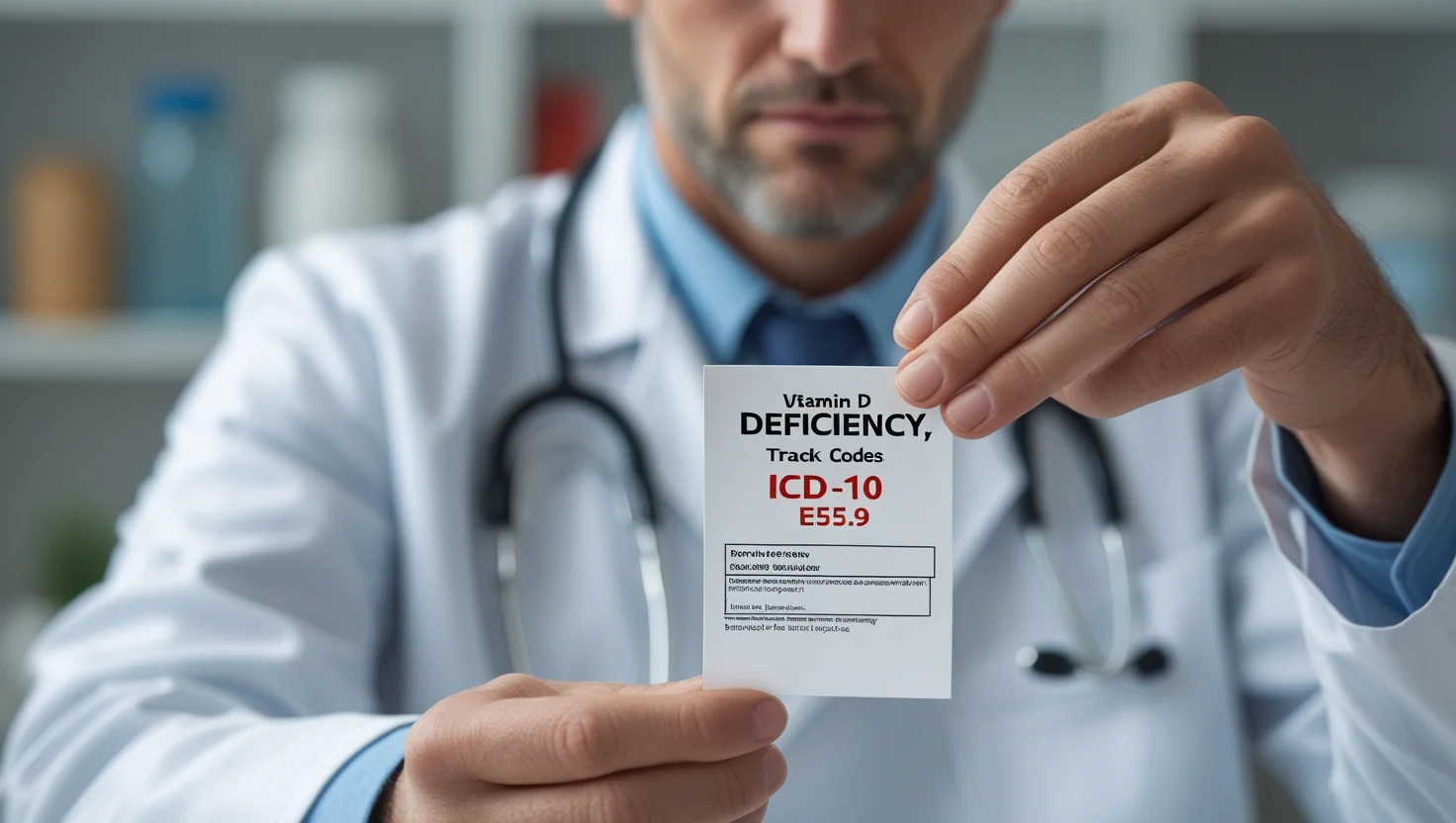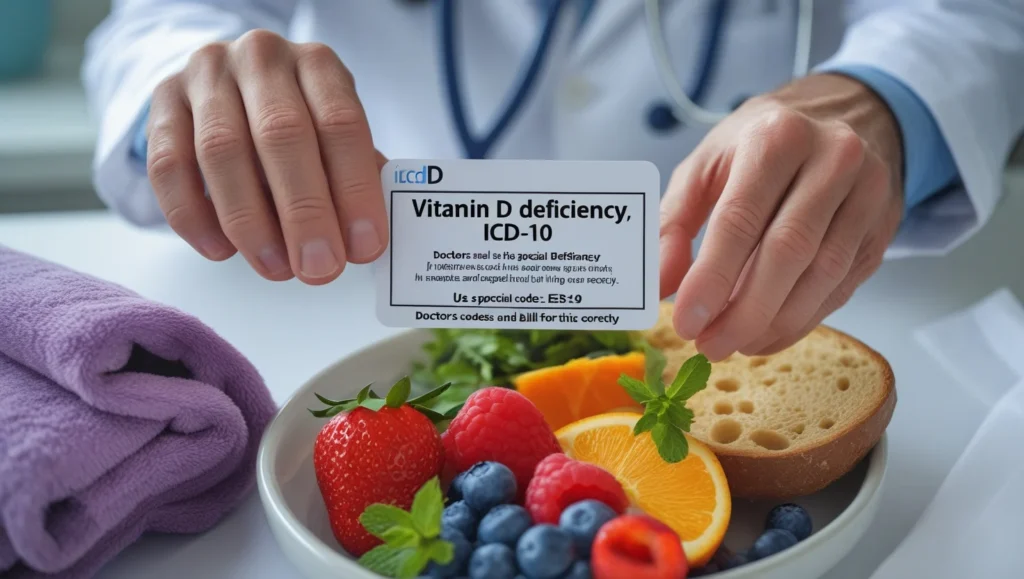Vitamin D Deficiency icd-10 (E55.9): Crucial Facts You Must Know About It

Have you ever felt tired all the time or had achy bones? These might indicate low amounts of vitamin D. Vitamin D maintains the health and strength of your body. It functions as a support system for your muscles and bones.. But many people lack enough of it. It is called vitamin D deficiency. Doctors use special codes to track this issue. Vitamin D deficiency, ICD-10, is the main one. ICD-10 stands for International Classification of Diseases, 10th version.
It helps doctors and hospitals bill for care correctly. The code for vitamin D deficiency ICD-10 is E55.9. It means unspecified vitamin D deficiency. Why does this matter? It ensures patients get the right help. Around the world, about 1 billion people have low vitamin D. In the US, 35% of adults face this problem.
This article breaks it down. We cover causes, signs, and how the vitamin D deficiency ICD-10 code works in medical billing. Let’s dive in to learn more.
Why Do We Need Vitamin D? What Is It?
Vitamin D is like the sunshine vitamin. Fish or milk are the main sources of it. This vitamin keeps bones strong. It helps your body take in calcium. Without enough, bones can get weak. Kids might get a disease called rickets. Their legs bow out. Adults could have soft bones, known as osteomalacia.
Many folks don’t get enough sun. They stay inside a lot. Dark skin needs more sun to make vitamin D. Older people make less of it, too. Some diseases stop the body from using vitamin D well. For example, kidney problems or gut issues like Crohn’s disease.
Stats show big numbers. In the US, 24% have levels below 50 nmol/L. That’s low. In Europe, it’s 40%. Worldwide, over 20% in places like India have very low levels. Think about a busy mom who works indoors. She might not be aware that a vitamin D deficiency is the cause of her low energy. Doctors look for 25-hydroxyvitamin D in blood. For documentation purposes, they utilize the vitamin D insufficiency ICD-10 number E55.9 if it is low.
This code falls under endocrine and nutritional diseases. It helps track how common this is. Hospitals use it for billing. If you feel weak, ask your doctor about a test. Simple fixes like more sun or pills can help.
Causes of Vitamin D Deficiency ICD-10
What makes vitamin D levels drop? Lack of sun is a big one. If you live far north, winters bring less light. Clothes that cover skin block rays, too. Some people can’t absorb vitamin D from food. It occurs during stomach surgery or with celiac disease.. Medicines like seizure drugs speed up vitamin D breakdown.
Obesity plays a role. Fat cells trap vitamin D. So, it can’t flow in the blood. The body cannot convert vitamin D into its active form if there are problems with the kidneys or liver. Babies breastfed without extra vitamin D might lack it. Old folks in nursing homes often stay inside.
Real example: A man with Crohn’s disease had ongoing belly pain. His doctor found low vitamin D. They coded it as vitamin D deficiency, ICD-10 E55.9. Treatment started fast. Stats say 50% of people worldwide have some insufficiency. In Canada, 37% are below healthy levels. To avoid this, eat fatty fish like salmon. Get 15 minutes of sun daily. But don’t burn. If at risk, talk to a doctor. They might suggest supplements. Always check labels for safe amounts.
Risk Groups for Low Vitamin D
Certain people face higher chances. Pregnant women need more for the baby. Dark-skinned kids in cloudy areas often test low. Folks over 65 make less from the sun. Those with chronic kidney disease see levels drop. According to research, 60% of people in nursing homes do not get enough vitamin D.

Symptoms Linked to Vitamin D Deficiency ICD-10
Tiredness hits first. You feel worn out even after rest. Bones ache, especially in the back. Muscles get weak or cramp. Hair might fall out more. Kids grow slowly or have bowed legs. In adults, mood dips. You might feel sad or anxious.
Severe cases bring pain when walking. Fractures happen easily. Healing slows after cuts. Some get more colds. A woman felt constant fatigue. Her test showed a deficiency. Pills helped her energy return.
Not everyone shows signs. That’s why tests matter. If symptoms match, see a doctor. They measure blood levels. Below 30 nmol/L is severe. Aim for 50 or more. Simple changes fix it. But ignore it, and bones weaken over time.
Common Signs in Kids and Adults
Kids might cry from bone pain. Adults notice mood swings. For example, a teacher had muscle aches. Her vitamin D was low due to indoor work.
ICD-10 Code for Vitamin D Deficiency Explained
The vitamin D deficiency ICD-10 code is E55.9. It means unspecified vitamin D deficiency. Doctors use this when the type isn’t clear. It’s billable for insurance. This code is under other nutritional deficiencies. Synonyms include avitaminosis D.
Why use codes? They standardize records. Hospitals track trends. For billing, it’s key. But for active rickets, it’s E55.0. Convert to old ICD-9 if needed.
In clinics, coders check notes. They ensure the vitamin D deficiency ICD-10 matches symptoms. For example, a patient with fatigue gets tested. Low levels lead to E55.9 in files. It helps get paid for care. Guidelines say to use it only for true deficiency.
How Coders Pick the Right Code
Coders read doctor notes. If unspecified, E55.9. For related issues like osteoporosis, add M81.0.
Diagnosis and Vitamin D Deficiency ICD-10 Documentation
To find vitamin D deficiency, doctors order blood tests. They look at 25(OH)D levels. Below 20 ng/mL is deficient. They ask about diet and sunlight. Physical checks spot bone issues.
Documentation is vital for vitamin D deficiency ICD-10. Notes must show symptoms and test results. It supports code E55.9. For billing, clear records avoid denials. Example: A senior with falls gets tested. Low vitamin D noted. Code added to the chart.
Tests aren’t routine. Only if risks like obesity or dark skin. In hospitals, they use vitamin D deficiency ICD-10 for stats. This tracks how many cases. Worldwide, 15.7% have very low levels. Doctors advise supplements if low.
Steps in Diagnosis
First, talk about symptoms. Then the blood draw. Results guide code. Always note why the test was done.
Treatment Options Using Vitamin D Deficiency ICD-10
Fixing low vitamin D is easy. Take supplements. D3 is best, from over-the-counter. Dose starts at 600 IU daily. For severe, higher, like 50,000 IU weekly. Eat foods like tuna or fortified cereal.
Sun helps too. 10-15 minutes midday. But use sunscreen after. For kids with rickets, treatment straightens bones. Energy improved in weeks.
Doctors track progress with tests. Use code for follow-ups. If the disease causes it, treat that first. Like for celiac, change diet. Tips: Pick D3 over D2. Check with the doctor for the dose. Too much causes issues like high calcium.
Safe Supplement Use
Start low. Retest in 3 months. Avoid over 4,000 IU daily without advice.

Coding Guidelines for Vitamin D Deficiency ICD-10
Guidelines keep coding right. Use E55.9 for unspecified. Don’t use for other vitamins. Notes must back it up. For testing, covered if medical need. Like for osteoporosis or kidney disease.
Billers check for related codes. Example: Add N18.30 for chronic kidney. Reimbursement needs an accurate vitamin D deficiency ICD-10. Limits: Four tests yearly for E55.9.
In records, detail symptoms. It meets the rules. Coders train on updates. 2025 version effective October 2024. Examples: Fatigue plus low test = E55.9.
Common Mistakes in Coding
Mixing with other deficiencies. Always specify if possible.
Vitamin D Deficiency Billing and Associated ICD-10 Codes
Other codes link to vitamin D issues. E55.0 for active rickets. M81.0 for age-related osteoporosis. N18.30 for kidney disease stage 3. These often pair with vitamin D deficiency, ICD-10.
For billing, use primary code E55.9 if the main issue. Add others for the full picture. Insurance covers tests if the codes match the guidelines. For instance: A Patient with hypertension and low vitamin D.
Reimbursement varies. Clear docs help. Related: E78.5 for high lipids. Use for complete records.
Billing Tips
List all codes. Note test reasons. Avoid routine checks.
In short, vitamin D deficiency affects many. The vitamin D deficiency ICD-10 code E55.9 helps manage it. Get sun, eat right, and see a doctor if tired. It boosts health. Remember, this isn’t medical advice. Always consult experts.
FAQs
What is vitamin D deficiency ICD-10 code? For unidentified instances, the ICD-10 classification for vitamin D insufficiency is E55.9.
How do doctors diagnose Vitamin D deficiency ICD-10? They use blood tests to check levels and add the code to the records if low.
What are common symptoms of Vitamin D deficiency? Tiredness, bone pain, and muscle weakness are key signs.
Can Vitamin D deficiency ICD-10 affect billing? Yes, it helps get insurance to pay for tests and treatment.
What foods help prevent Vitamin D deficiency? Eat fish, eggs, and fortified milk to boost levels.
Key Citations
- ICD10Data.com – E55.9
- Cleveland Clinic – Vitamin D Deficiency
- PMC – Vitamin D Deficiency Update
- CMS – Billing for Vitamin D
- RML Online – ICD-10 Flyer
Disclaimer
This article gives general facts about vitamin D deficiency and its ICD-10 code. It is for learning only. It does not give medical advice. Please do not use it to check or treat health problems. Always talk to a doctor or health expert for your own care. They know what is best for you.
Rules can change. Check with billing experts or official guides from CMS for the right use. We used info from trusted places, but it might not be the newest. We are not to blame if you use this info and something goes wrong.
If you feel sick, see a doctor right away. Do not wait because of what you read here.
